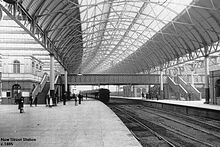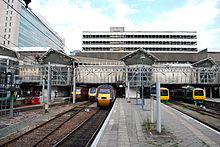Birmingham New Street Railway Station
| Birmingham New Street | |
|---|---|
|
Birmingham New Street in September 2015
|
|
| Data | |
| Platform tracks | 13 |
| abbreviation | BHM |
| opening | 1854 |
| location | |
| City / municipality | Birmingham |
| Metropolitan Borough | Birmingham |
| Part of the country | England |
| Country | United Kingdom |
| Coordinates | 52 ° 28 '40 " N , 1 ° 53' 56" W |
| Railway lines | |
|
Long-distance traffic: |
|
| List of train stations in the United Kingdom | |
Birmingham New Street is the main railway station of the British city of Birmingham . The station on the West Coast Main Line is one of the most important hubs on the UK rail network. With more than 35 million travelers annually, it is the busiest train station in Great Britain outside of London .
location
The train station is in Birmingham city center. Due to its central location in the UK, trains from different parts of the country stop at this station. Destinations include London Euston , Liverpool , Manchester , Scotland , Cardiff , North Wales , Bristol , Penzance , Nottingham , Leicester , Shrewsbury and Newcastle upon Tyne . The station is also the terminus of several suburban lines in the West Midlands , for example to Lichfield and Redditch .
In downtown Birmingham there are other train stations near New Street, such as Snow Hill and Moor Street on the Chiltern Railways , which are not directly connected to New Street, although the trains to New Street cross Moor Street station directly underground.
history
Before World War II
New Street was built from 1846 to 1854 as a shared station for the London and North Western Railway (LNWR) and the Midland Railway (MidR) to replace several previously constructed, disconnected stations. The best known was Curzon Street Station .
The new station was officially opened in a cautious manner on June 1, 1854, although operations had already started in 1851. On the same day, the Queen's Hotel belonging to the station was opened. The four-story building with originally 60 rooms was kept in a simple, Italian style.
The original station was designed by Edward Alfred Cowper and built by Fox, Henderson & Co. who also built Paddington Station and the Crystal Palace in London. When it was completed, it had the largest steel and glass hall roof in the world, with a span of 212 feet (approx. 65 m) and a length of 840 feet (approx. 260 m). It wasn't until St Pancras station in London, opened in 1868, that an even larger hall was built.
At the end of the 19th century, an extension designed by Francis Stevenson, the LNWR's chief engineer, became necessary. It took place on the south side of Queen's Drive, where the part occupied by the MidR was now, while the LNWR used the entire northern part of the station. From then on, Queen's Drive ran through the middle of the station, which now had 15 edges and covered an area of 4.8 hectares, which made it the largest station in the country when it opened in February 1885. In 1917 the LNWR expanded the Queens Hotel, which became twice as large after the addition of a west wing in 1917. In 1923 the two railway companies went on to become the London, Midland and Scottish Railway (LMS).
After the Second World War
During the Second World War , New Street suffered considerable bomb damage, which necessitated extensive work on the building structure and the replacement of the roof. The state company British Rail decided to modernize the West Coast Main Line in the 1950s. In 1964 the old station was demolished together with the Queen's Hotel and replaced by a new building designed by Kenneth J. Davies. A concrete slab supported by 200 columns was placed above the platforms, on which a shopping center was built. The 20-story Stephenson Tower was also built on the station grounds. The station opened in 1967 - the same year electrical operations began on the West Coast Main Line.
Remodeling in the 2010s
The modernized station was under heavy criticism from the start, mainly because of the dark, uncomfortably narrow-looking platform area. More than 140,000 passengers used the station every day, more than twice as many as originally planned, so that the demands for a new building became louder and louder. Asbestos removal was also necessary. The infrastructure company Network Rail, as the operator of the station, announced the redesign in 2006. Construction started in 2010 and included the demolition of the Stephenson Tower. The shopping center has been upgraded and is now called Grand Central , based on the Grand Central Terminal in New York . The main tenant is the luxury department store chain John Lewis & Partners , which occupies 23,000 m².
The redesign was completed in 2015. The new three-story concourse is much larger than the old one and allows natural light to enter the entire station. The bubble-shaped roof is made of ETFE , the same material that was used for the outer shell of the Allianz Arena .
Individual evidence
- ↑ a b c d e f The history of Birmingham New Street station. Network Rail, accessed April 12, 2020 (UK English).
- ↑ Birmingham New Street's 150-year history revealed as station switchover nears. Netwrok Rail, April 22, 2013, archived from the original on February 2, 2014 ; accessed on April 12, 2020 (English).
- ↑ Mike Hitches: Birmingham Railways Through Time . Amberley Publishing Limited, 2011, ISBN 978-1-4456-2479-2 , pp. 70 ( google.ch [accessed April 12, 2020]).
- ^ A b c Birmingham New Street station refurbishment: Breathing new life into New Street. Retrieved April 12, 2020 .
Web links
- Birmingham New Street. Network Rail, 2020(English, website of the operator).
- Departure times in real time. Nationa Rail(English).
- Birmingham New Street (BHM). Nationa Rail(English).



